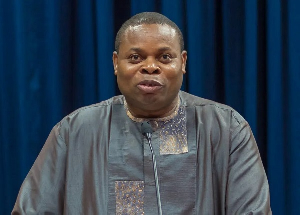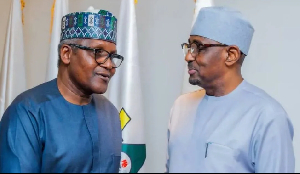A lot has been said about the proposed 40-year development plan in Ghana and I strongly believe the majority of Ghanaians will embrace it if it is done properly.
The members of the National Development Planning Commission (NDPC) have a very difficult task at hand but if they will listen not only to praise songs but also constructive criticisms and suggestions, they have a greater chance of producing a useful development plan for Ghana. In this regard, they have a duty to listen to both the unseen and seen powers in the Ghanaian society as they embark on crafting a long-term development plan for Ghana.
The unseen powers include taxi drivers, farmers, market women, bus drivers, hawkers, teachers, nurses and a host of other Ghanaians who are recognised by decision-makers only during general elections.
The seen powers include journalists, parliamentarians, professional associations, university professors, the judiciary, the executive, past presidents of Ghana, faith-based organisations, leadership of political parties and the presidency, including ministerial portfolios.
Empirical studies and data analysis
The NDPC must begin the planning process by burying their emotions, intuitions and personal or political beliefs and leanings. Instead, its work must be based solely on empirical studies and data analysis.
Their role is not to impose their own vision or goals but to help Ghanaians establish their vision and goals for the plan.
This is important because imposition, or a perceived imposition, of the development plan goals is detrimental to consensus building and public support.
Already, the NDPC has established a vision for the proposed plan – “A just, free and prosperous nation.” Of course that’s the vision of every nation under the sun but the problem here is that it’s being imposed on Ghanaians and that’s a recipe for failure. In the view of the NDPC, this vision could be achieved through the following established goals for the plan: (a) inclusive and resilient economy; (b) equitable and tolerant society; (c) safe and sustainable communities; (d) effective and efficient institutions; (e) contribution to World Peace and Justice.
Imposition of goals
These are noble goals but who decides what the goals of the 40-year development plan should be? Should it be the majority of Ghanaians or the NDPC? If the NDPC intends to make the plan binding on future governments, it must desist from imposing or seemingly imposing these goals on Ghanaians. Rather, it must be seen as helping Ghanaians to diagnose their development problems and sieve out the goals or vision for the proposed development plan.
According to the NDPC, both the vision and the goals were long given to Ghanaians in the Directive Principles of State Policy of the 1992 Constitution and have merely been pulled together to facilitate discussions. One can understand why the NDPC is relying on these principles but those principles are already 23 years old and some are even so broad that they are meaningless to most Ghanaians today.
It is not by accident that Constitutions are often amended to reflect changing circumstances. The NDPC has a great opportunity to study the past and current development problems in Ghana (e.g. “dumsor,” high vehicle accident rate, healthcare access, trade deficit, poor sanitation, judgment debts, high incidence of corruption, high inflation, poor urban planning, urban sprawl and flooding) and fashion out a vision or goals for the 40-year plan!
These are practical and specific issues that can generate public interest and greater participation than a vague goal like "contribution to world peace and security!” Greater public participation is the grease that will lubricate the planning process and ensure a broad acceptance of a binding development plan.
Recently, the NDPC has clarified the 40-year development plan as actually a succession of ten four-year plans to be implemented by various political parties. According to the Director General of the NDPC, Dr Nii Moi Thompson, “Over the 40-year period, there will be 10 national elections, and 10 four-year plans with the 10th one in 2056.
The key difference is that unlike the previous ones since the 4th Republic began, this one would be situated in a strategic context - a long-term 40-year plan. The kind of ambitious infrastructure development we need to cater for our social and economic needs leading to our 100th anniversary will require a long-term planning horizon.
” To the average Ghanaian, this is a little vague but one of the cardinal principles for ensuring a binding development plan is to avoid vagueness. This is because vagueness may confuse stakeholders and the final plan may be equally confusing to stakeholders. Why can’t the NDPC stick with a 10 or 20-year development plan?
Suspicion
The NDPC’s insistence on sticking with a 40-year development plan could raise suspicion in the minds of many stakeholders, especially opposition political party leaders, as to the real intentions of the current government.
This is more so because the planner’s ability to empirically predict into the future beyond 20 years is very limited (who could have ever predicted the impact of technology or the Internet on the previously much-cherished Ghana’s P&T 40 years ago?). So why insist on a 40-year development plan at all cost? Most countries have had long-term vision plans but Ghana may be the first country on Earth to produce a 40-year national development plan. The two are not the same!
To sum up, the involvement of both seen and unseen powers in the planning process, avoidance of imposition or perceived imposition of national vision and goals, and a well-defined and effective plan period will go a long way to ensure a binding development plan more than any Act of Parliament.
The writer is a certified planner with the American Institute of Certified Planners and a planning professor at the University of Alabama, Tuscaloosa, USA. He was recently a visiting professor at the University of Cape Coast, Department of Geography and Regional Planning.
Opinions of Thursday, 20 August 2015
Columnist: Prof. Seth Appiah-Opoku














